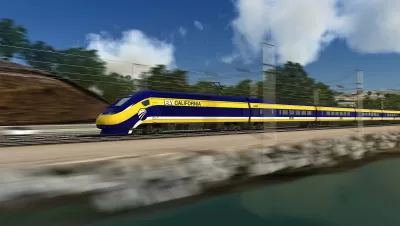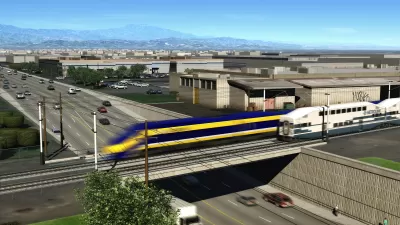Don't tell that to the 18,000 residents of Shafter. However, the Legislative Analyst's Office made clear in its March 17 report that it questioned having the southern end of the first operating segment located "in an unpopulated agricultural area."

"The nonpartisan office that provides fiscal and policy analysis to the state legislature says it’s concerned about uncertain funding in the California High-Speed Rail Authority’s latest draft business plan and also the proposal to end the initial operating segment (IOS) miles from the nearest urban area in the San Joaquin Valley," writes
[Correspondent's note: A good description of Initial Operating Segments (IOS) can be found in the second paragraph of this Wikipedia description].
The new IOS, referred to as IOS North, resulting from a (literal) change of direction in the draft plan, may be "cheaper and quicker to build," but the southern end in Shafter, 18 miles northwest of Bakersfield in Kern County, creates problems for potential passengers. The Legislative Analyst's report states:
[T]he Legislature will want to consider whether the southern terminus of the proposed IOS makes sense. [U]nder the plan, the IOS North would have its southern terminus at an agricultural area north of the small city of Shafter, which is about 50 miles south of the last planned station on the IOS. In order to make the southernmost portion of the IOS usable, HSRA plans to build a temporary station or platform at this location.
....Even with a temporary station or platform, ending the IOS in an unpopulated agricultural area does not appear to be an effective approach. This is because this location would not have the types of facilities and nearby businesses, such as transit connections, rental car facilities, and shops necessary to meet the needs of train passengers.
As for the northern end, the high-speed rail train will provide another answer to the question, "Do you know the way to San Jose?" At Diridon Station, passengers can transfer to what will hopefully be an electrified Caltrain for the 47-mile trip to San Francisco. [Currently the diesel-powered trip takes 59 minutes for a 'baby-bullet' or about 90 minutes for a local.]
The other major concern the Legislative Analyst's Office (LAO) expressed was funding—nothing new there as opponents have been pointing this out since the 2008 bond measure authorizing the project was approved by voters. The authority itself recognizes that the train will need to operate before attracting private funds.
However, the Legislative Analyst indicated concerns with the main funding source until the nearly $10 billion in bonds can be tapped.
"[T]he review notes that the possible end of cap-and-trade funding in 2020 'means that without legislative action, the cap-and-trade funds [high-speed rail] plans to use to build the IOS would likely not be available' for the remainder of segment construction, which is expected to be completed in 2025," writes Meacham.
A review of past LAO reports [see two posts in 'related' below 'tags'] on the mega-project show this one could have been a lot worse for the authority.
Expect one more review of the draft business plan to come from a separate Peer Review Group before the draft business plan is sent to the legislature for approval.
For a brief audio account on the LAO's report, click on Capitol Public Radio's report. See Juliet Williams article in The Associated Press (via The Fresno Bee) for a thorough write-up on the report.
FULL STORY: High-speed rail's funding, southern station location concern Legislative Analyst's Office

Planetizen Federal Action Tracker
A weekly monitor of how Trump’s orders and actions are impacting planners and planning in America.

San Francisco's School District Spent $105M To Build Affordable Housing for Teachers — And That's Just the Beginning
SFUSD joins a growing list of school districts using their land holdings to address housing affordability challenges faced by their own employees.

The Tiny, Adorable $7,000 Car Turning Japan Onto EVs
The single seat Mibot charges from a regular plug as quickly as an iPad, and is about half the price of an average EV.

With Protected Lanes, 460% More People Commute by Bike
For those needing more ammo, more data proving what we already knew is here.

In More Metros Than You’d Think, Suburbs are Now More Expensive Than the City
If you're moving to the burbs to save on square footage, data shows you should think again.

The States Losing Rural Delivery Rooms at an Alarming Pace
In some states, as few as 9% of rural hospitals still deliver babies. As a result, rising pre-term births, no adequate pre-term care and "harrowing" close calls are a growing reality.
Urban Design for Planners 1: Software Tools
This six-course series explores essential urban design concepts using open source software and equips planners with the tools they need to participate fully in the urban design process.
Planning for Universal Design
Learn the tools for implementing Universal Design in planning regulations.
Smith Gee Studio
City of Charlotte
City of Camden Redevelopment Agency
City of Astoria
Transportation Research & Education Center (TREC) at Portland State University
US High Speed Rail Association
City of Camden Redevelopment Agency
Municipality of Princeton (NJ)



























